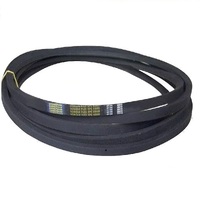
Suits John Deere - Non Genuine
Aramid Made Deck Belt for 42" Cut John Deere & Sabre Mowers GX20072 GY20570
$54.95
Belts are the unsung heroes of ride-on mowers, ensuring smooth operation by transmitting power from the engine to the deck or drive system. At Green Acres Mowers, we understand the vital role that durable, high-performance belts play in keeping your mower in peak condition. Whether you're upgrading for better performance, troubleshooting issues, or looking to extend the life of your belt, we’ve got you covered with expert advice and top-quality products.
Upgrading your ride-on mower belt can make a significant difference in performance and efficiency. Stronger, more durable options are designed to withstand higher stress and offer longer-lasting service. When choosing a upgrade, it’s essential to match the specifications of your mower model to ensure compatibility. Opting for reinforced belts can add extra strength and durability, particularly for heavy-duty mowing tasks. Installing a new belt upgrade requires careful alignment and tension adjustment to ensure it fits perfectly and functions smoothly.
How to Identify a Worn or Damaged Belt
A worn or damaged belt often shows signs like fraying, cracking, or glazing. If your mower’s performance has declined or the belt emits unusual noises, it’s time to inspect it closely for these telltale signs.
Steps to Replace a Broken Belt
Replacing a broken belt starts with locating the belt path using your mower's manual. Remove any covers, loosen the tension pulley, and carefully replace the old belt with a new one, ensuring it follows the correct routing. Tighten the tension pulley and reassemble the parts for a secure fit.
Reasons for Excessive Belt Wear
Excessive wear can result from improper tension, misaligned pulleys, or debris buildup. Operating the mower with a damaged or loose belt can exacerbate these issues, leading to premature failure.
How to Adjust Belt Tension on a Ride-On Mower
Proper belt tension is key to optimal performance. Too much tension can strain the belt and engine, while too little can cause slipping. Use the tension adjustment mechanism to achieve the right balance, following your mower’s guidelines.
Solutions for Belt Slipping or Coming Off During Use
Belt slipping or detachment may occur due to worn pulleys, incorrect tension, or a stretched belt. Inspect and replace damaged parts, adjust the tension, and ensure the belt is routed correctly to resolve these issues.
Proper Storage and Handling of Spare Belts
Store belts in a cool, dry place away from direct sunlight or moisture. Hanging belts rather than coiling them can prevent warping and ensure they maintain their shape.
How Weather Conditions Can Affect Belt Performance
Extreme heat or cold can degrade belt material, causing it to crack or lose flexibility. Avoid exposing belts to harsh weather conditions to extend their lifespan.
Cleaning and Lubrication Techniques for Belts
Clean belts regularly to remove dirt and debris that can cause wear. Avoid using excessive lubrication, as it can lead to slippage; instead, focus on keeping pulleys and surrounding areas clean.
How to Prevent Overheating and Warping of Belts
Overheating can weaken belts and cause them to warp. Ensure proper ventilation around the engine and avoid prolonged operation in extreme heat to keep belts in good condition.
Frequent inspections help catch minor issues before they escalate. Replace belts as needed to prevent breakdowns and maintain consistent mower performance.
At Green Acres Mowers, we offer a wide selection of high-quality belts for ride-on mowers, ensuring you get the best performance and durability. Whether you need an upgrade, a replacement, or expert advice, we’re here to help. Browse our collection online today and enjoy hassle-free delivery across Australia!